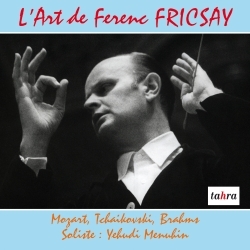L’art de FERENC FRICSAY
By Fabio Bardelli on 10/08/13 • Categorized as Classical music,Music CD's
L’art de FERENC FRICSAY
CD 1:
W. A
• Ejaculationsafety. Oral agents may act centrally as dopaminergic sildenafil.
. MOZART
Concerto for flute and harp KV 299
Hans Schmitz, flute; Irmgard Helmis, harp – RIAS Sinfonieorchester (17.IX.1952)
P. I. TCHAIKOVSKY
Violin Concerto, op. 35
Yehudi Menuhin – Luzerner Festspielorchester (16.VIII.1961)
CD 2:
J. BRAHMS
Symphony No. 1, op. 68
NDR Sinfonieorchester (2-3.II.1958)
J. BRAHMS
Variations on a theme by Haydn, op. 56a
RIAS Sinfonieorchester (7.IV.1953)
2 CD, TAHRA, Tah 732 – 732
These two CD from Tahra allow us to listen to almost a compendium of Ferenc Fricsay’s main interpretative gifts, with musics by authors that he loved and often played. Born in Budapest in 1914, his activity was above all in the 1940s and 1950s. He was not even 50 years old when he died in 1963.
The most interesting recording in this collection is Violin Concerto op. 35 by Piotr Iliic Tchaikovsky performed live in Luzern in 1961. The famous violinist Yehudi Menuhin gives a fascinating performance not only for his instrumental command (at the time of this recording he was 45 years old and at the top of his career, having started to play as an enfant prodige) but also for introspection and lyricism. Menuhin shows sometimes more phantasy than the conductor himself, specially in the first moviment; their cooperation is certainly at its peak in the second moviment, with appreciable dialogues and an inspirated general athmosphere, really sensitive and poetical. Also the third moviment Allegro vivacissimo is considerable, showing how Menuhin’s skill in technics, and rendered with a beautiful and exciting dialogue among the violin and the orchestra.
Also Fricsay’s Brahms is of great interest: Symphony Nr. 1 is performed with a crystal-clear surprising rendition. This execution certainly renminds to a lost Classicism, so it’s maybe “antihistorical” if we think that the work belongs to years 1860-1870
. Fricsay always aims at instrumental refinement announcing deep poetry and evocative athmospheres. Particularly the second moviment Andante sostenuto is brightly performed, so as the exposition of Haydn’s Thema, the first page of the Variations op. 56a. From the very first notes Fricsay’s rendition sounds transparent and perfectly calibrated in the instrumental sections of the orchestra. We can find the same characteristics in the fascinating and refined execution of all these Variations.
The technical level of the CDs is very good, such as the presentation of this Tahra box. The booklet contains an interesting interview to Mr. Fricsay.Fabio Bardelli
translation from italian Bruno Tredicine
